Engaging Sea Animal Activities for Preschool Learners
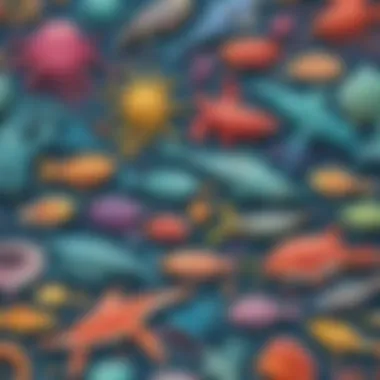
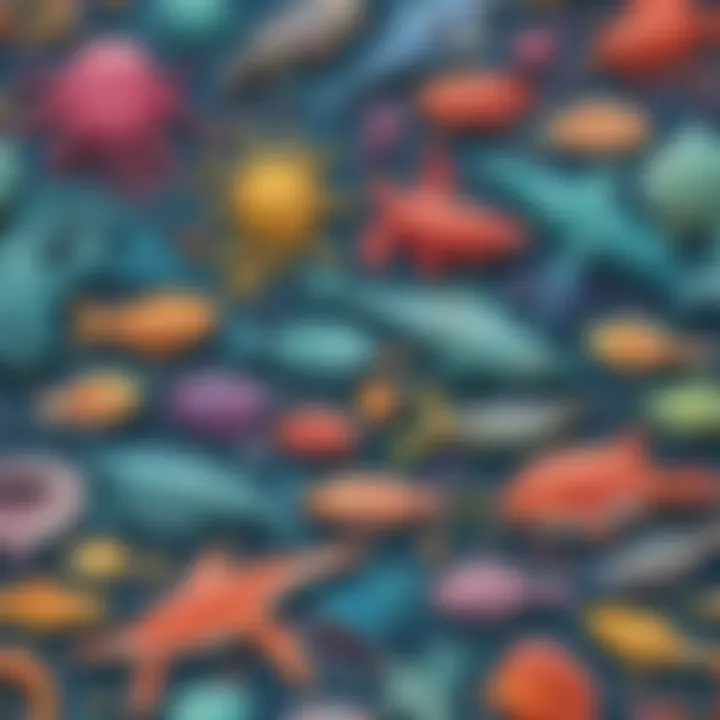
Intro
When it comes to sparking the imagination of preschoolers, the ocean is a treasure trove of inspiration. From the shimmering scales of fish to the soft flutter of jellyfish, sea animals can captivate young minds in ways few other subjects can. Every splash of a wave invites curiosity and exploration, making it a perfect theme for engaging activities that foster learning through play.
Through a blend of fun and education, children can dive into the mysteries of the marine world, gaining insights not just about sea creatures but also their own growth and development.
Science Fun Facts
Getting to know sea life is like opening a delightful book filled with surprises. Here are some amazing facts that can tickle a child's mind and encourage their curiosity about the ocean:
- The Blue Whale is the largest animal on the planet, measuring up to 100 feet long!
- Octopuses have three hearts. Two pump blood to the gills, while the third pumps it to the rest of the body. That's a lot of love from one critter!
- Did you know that sea turtles can hold their breath for up to five hours? They’re quite the divers!
- A group of jellyfish is called a smack—imagine all that gooey, wobbly fun!
- The vibrant colors of clownfish come from their close living arrangement with sea anemones, which protect them from predators.
"Learning about sea animals can turn a simple activity into an ocean of opportunities for exploration and discovery."
Discover the Wonders of Science
Finding ocean wonders means embracing the curiosity that lies within a child's heart. Here’s how to make science come alive:
- Exploring Various Scientific Concepts: Preschoolers can learn about ecosystems, food chains, and even basic concepts like buoyancy simply by observing how different sea animals interact in their environments.
- Educational Videos and Animations: Utilizing beloved options like those on Youtube can visually draw children into the underwater world, making them eager to learn more.
- Interactive Learning Tools: Engaging apps or education platforms may offer interactive games about marine life, expanding their knowledge while keeping them entertained.
- Real-Life Applications of Science: Understanding how pollution affects the ocean gives children a tangible reason to care about their environment. Small, engaging conservation projects can emphasize these lessons and empower kids.
Foreword to Sea Animals
Understanding sea animals is not just a fun topic for preschoolers; it's a doorway into the vast, intricate worlds our oceans hold. The importance of integrating marine life into early education cannot be overstated. Engaging with sea creatures fosters curiosity and lays the groundwork for a child's learning journey. As kids explore the ocean's wonders, they begin to grasp ecological concepts, develop empathy for living beings, and even enhance their social skills through group activities.
Learning about sea animals offers myriad benefits:
- Cognitive Development: Children acquire knowledge about different species, habitats, and ecosystems, enhancing their cognitive abilities.
- Emotional Growth: Understanding marine life helps youngsters relate to creatures, promoting empathy and emotional intelligence.
- Creative Expression: Sea animals inspire art projects, storytelling, and imaginative play, allowing children to express themselves creatively.
When we dive into this topic, we don't just scratch the surface; we encourage a deep-rooted passion for learning that may last a lifetime. In the sections that follow, we will explore various dimensions of learning through sea animals, such as crafts, interactive games, and scientific experiments, all designed to stir curiosity and bridge connections with the marine world.
"The ocean stirs the heart, inspires the imagination and brings eternal joy to the soul." — Wyland
Understanding Marine Ecosystems
Marine ecosystems are rich and complex environments where various sea animals coexist and thrive. It comprises not only the creatures we know, such as dolphins and jellyfish, but also plants, coral reefs, and microscopic organisms that form the building blocks of these habitats. This interconnectedness is fundamental for children to comprehend, as it mirrors their own social environments.
Key Concepts:
- Habitats: Every animal needs a home! Kids will learn about different environments like coral reefs, tide pools, and the deep ocean.
- Food Chains: Sea animals participate in food chains, where each organism plays a vital role in the survival of others. This concept can be illustrated through fun, hands-on activities like creating playful posters or diagramming the food chain.
- Biodiversity: The sheer variety of life in the ocean is staggering. Children can marvel at how many types of fish there are, or why some creatures are bioluminescent.
Teaching preschoolers about these elements is not just about facts and figures; it’s about crafting a narrative that intrigues them, encouraging questions and discussions. Discussing marine ecosystems also introduces them to larger global issues, like conservation and the impact of pollution. This ensures they grow up with a sense of responsibility for the world around them.
By incorporating engaging activities around these themes, we aim to build a strong foundation in environmental awareness, allowing young minds to flourish. Let's embark on this journey together, as we turn our attention towards the engaging crafts that can illuminate this marine knowledge even further.
Crafts Involving Sea Creatures
Crafting offers preschoolers an opportunity to engage their imagination while learning about the world around them. The activities here focus on sea creatures, marrying hands-on creativity with educational elements. Crafting helps develop fine motor skills, promotes cognitive development, and encourages children to express themselves.
By working on sea-themed crafts, kids not only explore colors and shapes but also deepen their understanding of marine life. The tactile nature of these activities fosters sensory exploration, making learning both enjoyable and effective. Let’s dive into a couple of fun projects that showcase the beauty of ocean life.
Creating Paper Plate Fish
Materials Needed
To get started, let’s gather all the materials required for making paper plate fish. Simple materials like paper plates, markers, glue, and tissue paper can be used. This choice of materials is excellent as they're generally easy to find and even easier to handle for young children. Moreover, these components are not only safe for kids but also allow for a range of creative possibilities. The distinctiveness of paper plates makes them an attractive option, as their circular shape mimics the fish body easily.
Step-by-Step Instructions
Step-by-step instructions provide clear directions, which are crucial for preschoolers to follow along with. This approach helps enhance comprehension skills while providing a structure to creativity. When children have a sequence to follow, they gain confidence in completing tasks. This process also allows for collaboration, as they might enjoy working together, showing teamwork, and exchanging ideas on colors and designs.
Educational Value
The educational value of this activity cannot be understated. Not only does it introduce kids to the world of sea creatures, but it also allows them to explore concepts like symmetry and colors. Through this process, they develop a better understanding of their designs and can articulate why they chose certain colors or patterns. The hands-on experience provides an ideal platform for discussions about real fish and their habitats, deepening their knowledge about marine life. This craft is an excellent balance of fun and learning.
Making a Jellyfish with Streamers
Required Supplies
To create a jellyfish, specific supplies required include a paper cup, streamers, and craft glue. This combination is favorable since it’s lightweight and easy for little hands to manipulate. The vibrant colors of the streamers can attract children's attention and encourage them to experiment further with their design. Plus, paper cups are an economical choice, making this project budget-friendly for parents and educators alike.
Procedure
The procedure for crafting a jellyfish is straightforward. Kids can cut streamers to desired lengths and attach them to the paper cup. Following simple steps helps build patience and understanding of cause-and-effect relationships, as they watch their jellyfish come to life. Engaging in this type of activity enhances a child's problem-solving skills, as they might figure out the best way to attach the streamers securely.
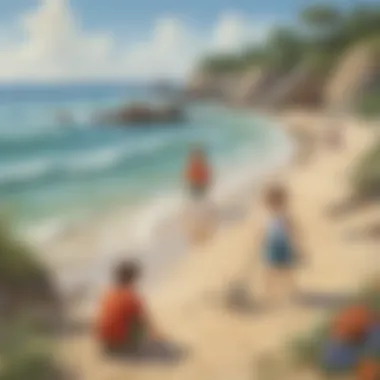
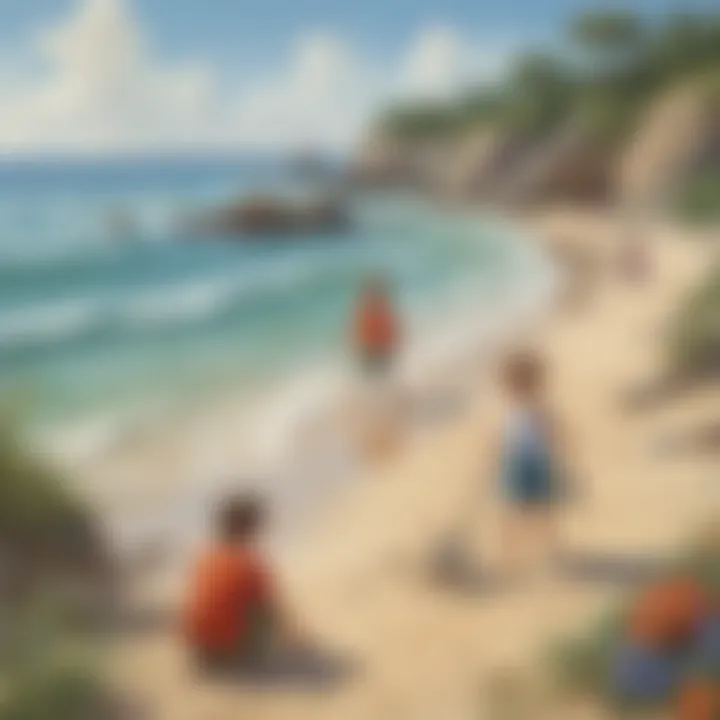
Learning Outcomes
Finally, discussing the learning outcomes is integral to understanding what children gain from this activity. They not only develop fine motor skills by manipulating the glue and streamers but also learn about jellyfish, their colors, and ways of life in the ocean. These discussions can lead to questions about how jellyfish swim or where they live. This deeper inquiry can encourage curiosity about the marine ecosystem, bridging the gap between crafting and real-world learning.
Interactive Games Featuring Sea Life
Engaging young minds through play offers many benefits, especially when the focus is on interactive games that feature sea life. These activities not only capture the children's imagination but also serve educational purposes that complement their learning. Integrating themes of marine life into games can deepen children's understanding of the ocean, its creatures, and their habitats, while simultaneously honing skills such as teamwork, problem-solving, and motor abilities. These games act as a bridge between learning and fun, making them a perfect fit for preschoolers.
Ocean Treasure Hunt
Setting Up the Game
To kick off the ocean treasure hunt, one needs to create an inviting environment that mirrors an underwater realm where children can envision themselves as explorers. This game could easily be adapted for indoor or outdoor spaces. Start by hiding various items—or "treasures"—in the designated area. These treasures could range from plastic sea creatures to glittery beads representing pearls, all adding to the ocean-themed adventure. A notable characteristic of setting up the game is its flexibility; you can tailor it based on space and available materials.
One unique feature of this setup is the use of maps or clues that lead to each treasure. Not only does this add an element of surprise, but it also encourages critical thinking as kids decipher clues, transforming a simple hunt into an engaging learning experience.
Rules and Objectives
The rules for the ocean treasure hunt are straightforward, making it easy for preschoolers to grasp them quickly. The primary objective is to team up and find all hidden treasures using the clues provided. This simplicity is beneficial as it fosters enthusiasm without causing frustration, ensuring that all participants can join in with equal excitement.
One unique facet here is the incorporation of fact cards about each treasure, which kids can read once they discover them. This could spark curiosity and lead to further discussions about marine life. However, while the simplicity of these rules is an advantage, a common downside could be the potential for competitive tension among children, depending on their personalities.
Skills Developed
Through the ocean treasure hunt, several key skills are cultivated. Problem-solving stands out, as children must think critically to follow clues or map directions. This aspect of the game encourages cooperation, allowing little ones to work alongside peers, sharing ideas and strategies—traits that are essential for their social development.
Moreover, cognitive skills are also enhanced through decision-making, as kids must discern the best paths to uncover the treasures. An interesting aspect is the physical activity involved; running and searching enhances gross motor skills, vital for this juvenile stage. But one should also take into consideration that the excitement of hunting can be overwhelming for some, which may deter those who prefer quieter activities.
Memory Match with Sea Animals
Materials Required
For a memory match game, all you need are some simple materials, usually a set of cards featuring various sea animals. Creating these cards can even be a fun craft project in itself! The fact that this game requires minimal supplies makes it accessible for many classrooms and homes. Plus, printing images of sea life from various resources like britannica.com can make the cards visually appealing and informative.
A distinctive characteristic of the card material is its potential for customization. Parents and educators can choose between illustrations or actual photographs of sea creatures, giving the game a unique twist that can cater to individual learning styles. However, one downside might be that if cards are not well-made or durable, they can easily become damaged, which ultimately affects repeated gameplay.
Gameplay Instructions
The gameplay for the memory match is quite intuitive. Cards are laid face down in a grid pattern, and players take turns flipping over two cards at a time, hoping to find matches. This straightforward approach helps children grasp the concept quickly yet also challenges their memory.
The joy of gameplay grows when children spot a match, and the sounds of excitement can be contagious. One unique feature is adding a timer to the game, which encourages quick thinking and adds a competitive edge, enhancing engagement. Nonetheless, while it's a fun and lively game, overly competitive play might lead to frustration for some preschoolers that are just learning to play.
Benefits of Play
The benefits of play in activities like memory match are manifold. Primarily, it aids in memory retention, as children engage in the mental challenge of remembering where different cards are located. Engaging in this back-and-forth enhances their cognitive functions significantly. Another key characteristic is that it strengthens social skills; kids learn to take turns, deal with winning and losing, and work together—all essential life lessons at an early age.
A unique aspect of the memory match game is its adaptability; you can expand it by incorporating facts about each animal depicted on the cards or even discussing their habitats. This not only enriches their vocabulary but also paves the way for deeper knowledge. However, a potential drawback lies in the fact that those who find it difficult to remember—or simply have a shorter attention span—might lose interest.
By introducing the immersive realm of sea life into games, caregivers can set the stage for a formative and enlightening experience. The joy found in these activities transforms learning into a lifelong interest in marine ecosystems.
Educational Activities Incorporating Science
When it comes to preschoolers, incorporating science into their learning about sea animals can be quite the reward. Engaging them in educational activities not only sparks their curiosity about the ocean but also enhances their cognitive development. Kids are naturally inquisitive, and weaving science into their play makes learning fun. The hands-on nature of these activities allows them to explore and discover, promoting a deeper understanding of marine ecosystems.
Exploring the Ocean Ecosystem
Concept Overview
Understanding the ocean ecosystem is a cornerstone for preschoolers. It introduces them to the intricate relationships between various sea creatures and their habitats. This foundational knowledge helps children comprehend how every creature, from the tiniest plankton to the largest whale, plays a unique role in maintaining ecological balance. The vibrant biodiversity in ocean life captures young imaginations, making the concept an engaging element in this article. An appealing aspect of this overview is its broad approach – it encompasses everything from edible sea animals to coral reefs, allowing for diverse discussions.
Hands-On Experiments
Nothing beats the excitement of hands-on experiments in keeping young minds active. These activities could involve sand, water, and replicating tidal movements in a simple setting. Not only do they promote tactile learning, but they also allow children to witness science in action. The charm of these experiments lies in their simplicity; all you need is common household items. They effectively illustrate scientific principles, such as buoyancy, and spark further questions about how sea animals adapt to their environment.
Analysis of Results
The process of discussing the outcomes of the hands-on activities adds another layer of learning. Children naturally love to talk about what they discover. It encourages them to compare expectations with reality, fostering critical thinking. Discussing results can also enhance their communication skills, as they learn to articulate their observations to peers and adults alike. One unique feature is the opportunity for them to document their findings creatively, whether it be through drawings or simple graphs, solidifying what they've learned.
Learning about Ocean Currents
Demonstration Setup

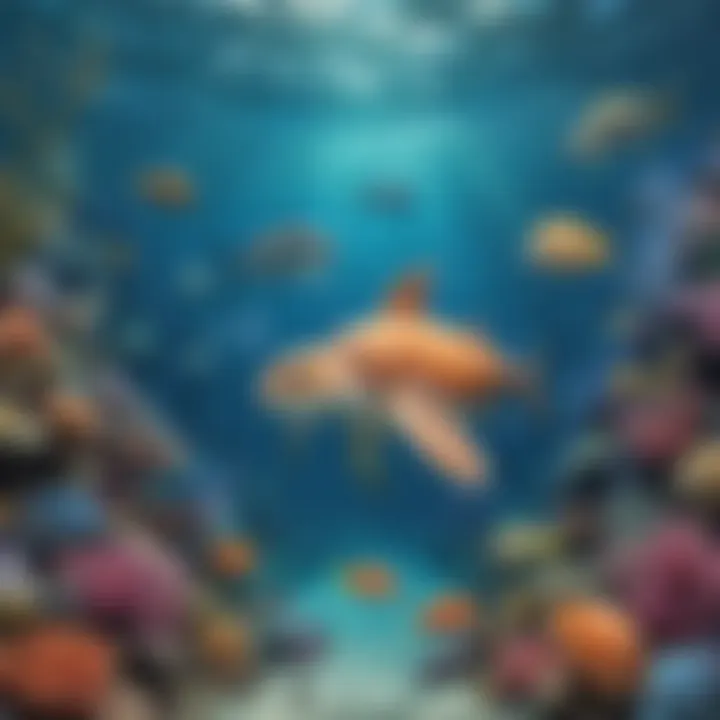
Setting up a demonstration about ocean currents is astonishingly fun and relatively easy. You can get started with just water, food dye, and a transparent container. The visual trick of currents created in their own mini-ocean captivates children’s attention. This stimulates curiosity about how currents affect marine life, such as how turtles migrate across vast distances. A benefit of this setup is that it requires minimal resources while providing a significant educational punch.
Observation Techniques
Encouraging preschoolers to observe the patterns formed by food coloring can enhance their analytical skills. In this part, they learn to note how the dye flows and interacts with the water movement. Simple observations will lead to discussions about how different ocean conditions affect sea creatures, forming another link in their understanding of marine ecosystems. This aspect is a prime example of experiential learning, helping kids connect theory with observation.
Discussion Points
Post-observation discussions are vital. Foster conversations about how ocean currents influence migration and feeding patterns of marine species. These dialogues should be open-ended, inviting children to ponder and share their insights. This interaction not only supports verbal skills but also reinforces the scientific concepts they just explored. Moreover, discussing varying perspectives can lead to a more comprehensive understanding of the ocean ecosystem.
Science activities not only cultivate curiosity but also develop a solid base for young learners, preparing them for future adventures in knowledge.
By integrating these enriching educational activities into playtime, preschoolers get a vivid, hands-on education about the ocean and its inhabitants, fostering a lifelong interest in marine science.
Storytelling and Literature on Marine Life
Storytelling brings marine life to the forefront in a way that engages preschoolers, breathing life into the creatures of the sea. This section explores how narratives serve not just as entertainment but also as vital educational tools. Through stories, children can develop an appreciation for marine ecosystems and the importance of conservation.
For young children, the bedtime story might just be a treasured ritual, but it also opens up pathways for learning about the ocean and its inhabitants. When they listen to stories that feature sea animals, children not only encounter new vocabulary but also grasp concepts of empathy and respect for nature, which could shape their understanding of the world.
Reading Sea-Themed Books
Recommended Titles
When looking for books to introduce preschoolers to the wonders of the ocean, there are certain titles that truly stand out. "The Pout-Pout Fish" by Deborah Diesen is a favorite, with its rhythmic language and colorful illustrations that capture little one's attention. What makes this book particularly effective is its gentle message about kindness, wrapped in an engaging plot.
Another superb choice is "Commotion in the Ocean" by Giles Andreae, which uses fun rhymes and lively illustrations to introduce diverse sea animals. This one encourages participation, as the children often find themselves wanting to sing along with the verses about fish, dolphins, and crabs.
Discussion Questions
Discussion questions following a story can significantly enhance comprehension and retention. By asking preschoolers, “What do you think happens next?” or “How would the fish feel in that situation?”, caregivers can foster critical thinking.
Such questions keep kids engaged, prompting them to connect their personal experiences with the characters in the story. This method develops their ability to comprehend narrative structures and different perspectives, which are crucial skills in both reading and social settings.
Important Note: Discussion questions can also lead to deeper conversations about ocean conservation, making it a perfect bridge to larger themes while staying age-appropriate.
Extension Activities
Extension activities transform the reading experience into something hands-on. After enjoying a book like "The Rainbow Fish" by Marcus Pfister, children could engage in activities like creating their own rainbow fish using glittery materials. This not only solidifies their learning through creativity but also builds fine motor skills.
Another enriching activity is creating a story map, where kids illustrate their favorite scenes or characters from the book. By doing so, they reinforce their understanding of the plot and characters, while also allowing their imaginations to run wild.
Creating a Sea Animal Story
Story Outline Tips
Encouraging kids to create their own sea animal stories can be a rewarding experience. It's essential to give them a simple structure to follow, such as beginning, middle, and end, which can facilitate the storytelling process.
Offering a template can be beneficial, helping them focus on the narrative without feeling overwhelmed. This can encourage both creativity and organization, skills that are invaluable later in life.
Encouraging Creativity
Promoting creativity isn’t just about making things pretty; it’s about allowing children to express themselves. Using prompts like, “If you were a sea turtle, what adventures would you have?” sparks their imaginations. This freedom to imagine can lead to truly unique stories, fostering a sense of ownership over their creations.
Also, providing a variety of art supplies—like colored paper and crayons—empowers kids to bring their stories to life visually as well.
Presentation Ideas
Presenting their stories can be both fun and educational for preschoolers. Creating a small stage for them to act out their tales can help develop their public speaking and confidence. Using puppets or props can add a whole new layer to their presentations, making it more interactive.
In summary, storytelling and literature about marine life are not just forms of entertainment; they are important educational tools that foster rich discussions, inspire creativity, and develop essential skills in preschoolers. The ripple effects of these activities can touch various aspects of a child's growth, nurturing their curiosity about the ocean and its many wonders.
Experiments with Water Properties
Experiments with water properties serve as a fantastic way for preschoolers to explore fundamental concepts of physics and reveal the magic of the ocean. For young minds, the ability to witness and understand how weight and buoyancy work not only intrigues them but also lays the groundwork for scientific inquiry. Engaging in these activities promotes curiosity and prompts questions that form the basis of critical thinking and discovery.
Floating and Sinking Activities
Concept Explanation
Floating and sinking activities revolve around the ideas of buoyancy and density. Essentially, this means that some objects can rest on the surface of the water while others plunge to the depths below. The beauty of this topic lies in its simplicity and the lively discussions it can spark among preschoolers. Water propels children into a world of exploration without the need for fancy equipment or heavy scientific jargon. By exploring these concepts, kids can learn about the properties of different materials in a fun yet educational way. It’s intriguing how a simple object can behave so differently based on its content, shape, or size.
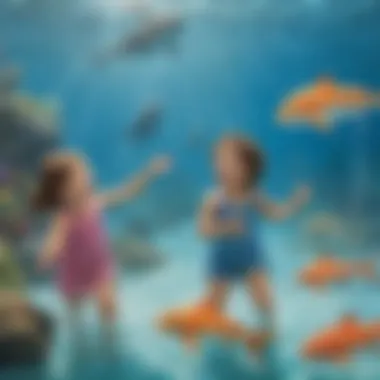
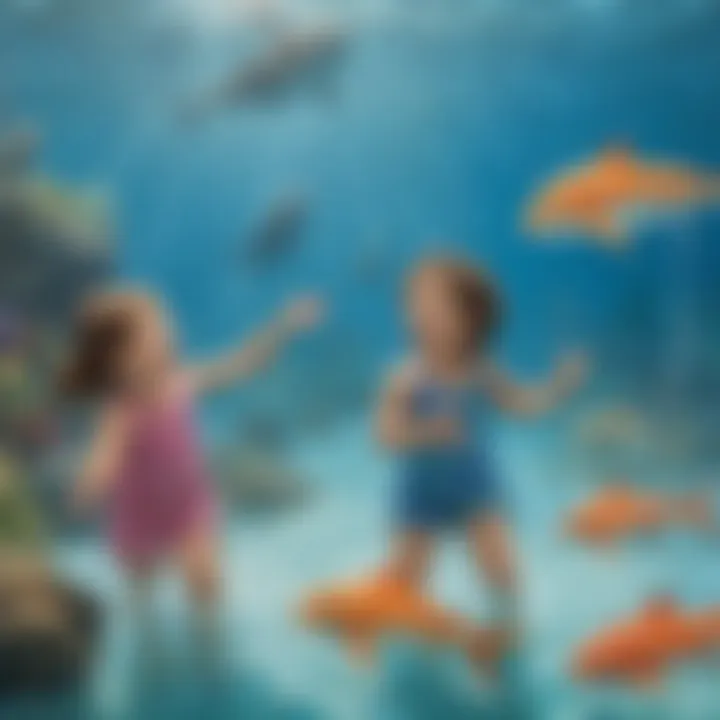
Experiment Steps
To facilitate these floating and sinking activities, the steps are straightforward and can engage multiple senses. Start by gathering assorted items – perhaps a feather, a stone, a plastic bottle, or toy animals. Make sure to have a basin or a clear container of water handy. By allowing the kids to hypothesize which items will float or sink before they make their observations, you encourage a natural sense of experimentation. After dropping each item in, the responses from the children—ranging from awe to surprise—will create a lively atmosphere. Such activities can foster group discussions and social interactions, vital aspects for preschoolers at this stage of development.
Discussion of Observations
After the hands-on exploration, it’s crucial to sit down and discuss what happened. Dialogue around why certain items floated while others didn’t draws connections to real-world scenarios. By guiding children through the reasoning behind each result, they start to understand concepts of buoyancy and density on a deeper level. Encouraging them to express how they feel about their discoveries nurtures emotional development and communication skills. This practice not only solidifies their understanding but also plants the seed for a scientific mindset as they learn to ask questions and investigate.
Investigating Water Density
Setup Instructions
Investigating water density introduces a delightful level of complexity to the initial floating and sinking activities. This step requires slightly more preparation but rewards with engaging insights. Begin by discussing how mixing liquids of different densities can create striking visual effects. To set the experiment up, gather essential supplies—corn syrup, water, and vegetable oil. A clear jar will help visualize the many layers formed when you pour each liquid in carefully. When preschoolers witness how each liquid interacts, it becomes a memorable experience that sticks!
Experiment Outcomes
The outcomes of this experiment can be mesmerizing. As the children watch corn syrup sit at the bottom, water take its space in the middle, and oil float on top, they are witnessing fundamental earth science principles unfolding right before their eyes. They might not realize it, but they observe the very reasons ocean currents work the way they do. The layers create an opportunity for discussions about marine life and how some creatures, like certain fish, can thrive in varying densities. The understanding that liquids can behave differently based on their properties opens doors to deeper curiosity.
Relation to Marine Life
Finally, tying these findings back to marine life enriches the children's learning journey. Discuss how water density affects the habitats of various ocean creatures. For instance, some fish are found in deeper regions where the density shifts. This points to the interconnectedness of knowledge.
Young minds widen as they connect the dots—seeing science not just as an isolated subject but as part of a broader narrative that includes the lives of creatures they might encounter during their sea-themed explorations.
Exploring water properties enables a powerful mixture of observation, discovery, and discussion, crucial parts of a preschooler’s learning journey.
Whether they’re engaging in floating and sinking activities or diving into water density experiments, preschoolers are enriching their understanding of the world while igniting their natural curiosity!
Visit to an Aquarium
Visiting an aquarium can be an enchanting experience for preschoolers, serving as a fantastic gateway to learning about sea animals in a lively, interactive environment. Not only do aquariums showcase a rich array of marine life, they also help in sparking curiosity and fostering a connection with the ocean. The sights and sounds of an aquarium engage children’s senses, creating an unforgettable exploration of the underwater world. Young visitors can observe creatures like vibrant clownfish, elegant jellyfish, and mysterious sea turtles up close, turning education into an adventure.
Preparation for the Trip
Checklist of Items
Before heading off to the aquarium, it’s essential to have a well-thought-out checklist of items that will make the visit smooth and enjoyable. This list typically includes:
- Comfortable clothing - As kids may be walking quite a bit.
- Snacks and water - Keeping munchkins fueled up helps maintain energy levels.
- Notepad and crayons - For sketching favorite marine animals.
- Camera or smartphone - To capture special moments.
A checklist not only helps in preventing any last-minute stress but also serves as a fun activity for kids. They can tick off items as they pack, adding a layer of excitement. This preparatory step contributes greatly to the overall experience, ensuring that nothing crucial is forgotten and that the kids are well-equipped for their underwater adventure.
Discussion Points for Kids
Having discussion points ready is like packing an extra treasure map for the brain! This can lead to enriched conversations during and after the visit. Topics might include:
- What do you see? Name three sea animals!
- What’s the most colorful fish? Why is it important?
- How do sea turtles swim so gracefully through water?
These discussion prompts encourage children to be observant and engaged, promoting their cognitive skills. They help children articulate their thoughts and foster a sense of wonder, making the experience more meaningful. Furthermore, discussing these points aids in retention of information and stimulates an ongoing interest in marine life.
Safety Guidelines
Establishing safety guidelines is essential, especially when dealing with excited little ones in a bustling environment. Important points to keep in mind include:
- Stick together - Always keep an eye on each other and stay close as a group.
- Use handrails - Ensure kids use handrails while moving around, especially near tanks.
- Respect boundaries - Remind children not to tap on glass or try to touch the animals.
These guidelines ensure a safe and enjoyable experience, allowing everyone to focus on the mesmerizing exhibits. By stressing the importance of safety, caregivers instill a sense of responsibility in the kids while allowing them to fully immerse themselves in the wonder of sea creatures.
This trip is not just a visit; it’s an adventure into the wonderful world beneath the waves, providing irreplaceable memories and lessons.
Closure: Cultivating Curiosity about the Ocean
The ocean is a treasure trove of wonders, and nurturing a child's intrigue about it can set the foundation for a lifetime of exploration and education. This article presents various engaging sea animal activities that do more than just entertain; they spark an interest in marine life that can grow as the child does.
Incorporating hands-on activities related to sea animals not only helps children learn about these creatures but also enhances their cognitive skills through play. These activities encourage questioning, observation, and experimentation, which are vital components of scientific inquiry. When preschoolers engage in crafting, storytelling, and interactive games revolving around sea life, they develop critical thinking and problem-solving skills. This engagement can help them understand their environment better and appreciate the delicate balance of marine ecosystems.
"Curiosity is the compass that leads us to our next adventure."
Moreover, the emotional connection formed during these fun, educational activities can make learning memorable. Using creative outlets to explore the world of sea animals allows children to express their thoughts and feelings, fostering emotional intelligence. It's not just about making a craft or playing a game; it's about discovering and communicating their newfound knowledge and appreciation for marine life.
Fostering a Lifelong Interest
Fostering a lifelong interest in ocean life begins with early exposure and engagement. When preschoolers learn through active participation—be it creating a paper plate fish or embarking on an ocean treasure hunt—they form connections that last well into their adult years. This is crucial because research shows that experiences rooted in curiosity tend to stick with individuals longer than traditional rote learning.
To help children cultivate this long-term interest, caregivers should:
- Encourage Questions: Always welcome their inquiries about sea animals. Why do dolphins jump? What do jellyfish eat? This nurtures an inquisitive mindset.
- Share Real Stories: Sharing fascinating facts about marine animals can spark further interest. This could include tales of survival in ocean habitats or the importance of marine conservation.
- Promote Field Trips: Given the chance, take children to aquariums, beaches, or marine parks. Real-life encounters with animals create vivid memories that foster curiosity.
- Assure Regular Activities: Keep the activities fun and varied. Regular engagement with different crafts or games helps maintain interest.
- Incorporate Technology: Nowadays, there are lots of apps and videos that bring the underwater world to life. Make use of these resources to supplement learning.
By nurturing children's natural curiosity about the ocean through engaging activities, we can help shape a generation that cares deeply about marine life. With awareness comes responsibility, and who knows? Today’s curious preschoolers might just become tomorrow's passionate marine biologists.







